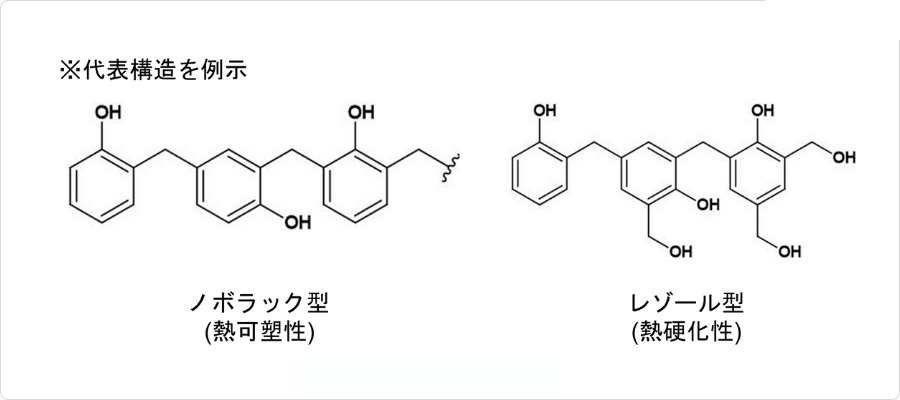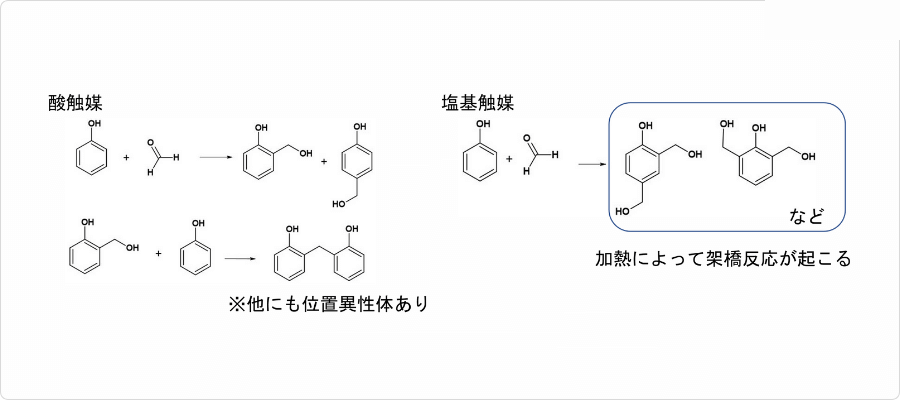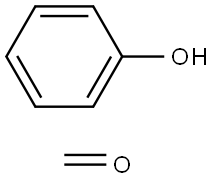-
種類

図1. フェノール樹脂の種類
フェノール類とアルデヒド類を反応させることで得られるフェノール樹脂には「ノボラック型」と「レゾール型」があります。ノボラック型の樹脂は酸触媒下で反応させることで得られ、再利用可能な熱可塑性樹脂です。一方でレゾール型は塩基触媒を用いて得られる再利用不可な熱硬化性樹脂です。
ノボラック型はエポキシ樹脂などの硬化剤とともに加熱することで硬化反応が起こり、高分子量化した樹脂が得られます。一方でレゾール型は硬化剤がない場合でも加熱や酸によって硬化反応が進みます。そのため、は貯蔵中にも経時変化を起こして高分子量化することがあります。
-
解説
フェノール樹脂,フェノール類とアルデヒドの縮合反応で得られる熱硬化性樹脂.クレゾール,キシレノールを主原料としたものを,とくにクレゾール樹脂,キシレノール樹脂ということもある.酸性触媒下の縮合反応では,初期からメチレンでフェノールが連結した生成物が得られ,この初期生成物をノボラックとよび,いろいろな成形品に用いる.アルカリ触媒の存在下による反応では,初期にメチロール基に富むレゾールを生成し,積層剤として用いられる.
森北出版「化学辞典(第2版)
-
用途
成形材料,接着剤,塗料
-
合成

図2. フェノール樹脂の合成
フェノール樹脂はフェノール類とアルデヒド類を付加縮合させることで得られます。ここでは代表例としてフェノールとの反応を紹介します。
上述の通り、酸触媒と塩基触媒で得られる化合物は異なります。酸触媒を用いた場合、フェノールのOH基のオルト位、またはパラ位で求電子置換反応が起こり、ホルムアルデヒドと反応します。そして反応後、別のフェノールとの間で縮合反応が起こり、ノボラック型の樹脂が得られます。
一方で塩基触媒を用いた場合はフェノールのベンゼン環に複数のホルムアルデヒドが反応してレゾールと呼ばれる油状の混合物が得られます。これを加熱することでレゾール同士が反応して結合したレジットと呼ばれる熱硬化性樹脂が生成します。
このように酸触媒と塩基触媒を用いた場合ではフェノール類とアルデヒド類の結合部位や反応する量が異なるため、得られるフェノール樹脂の構造や物性も異なります。
-
製法
製法としては,フェノールとホルムアルデヒドから酸の作用でノボラック樹脂をつくりこれに橋かけ剤を加えて加熱して固化する方法と,アルカリの作用で生成する初期縮合物 (レゾール) を加熱加圧して固化する方法,の2つがある。熱硬化性樹脂としては尿素樹脂とともに最も多くつくられている。
-
主な用途/役割
フェノール樹脂はフェノール、クレゾール、キシレノールなどのフェノール類とホルムアルデヒドなどのアルデヒド類の反応で得られる重縮合物の総称。木工用、合板用接着剤原料として使用される。
-
化学的特性
The phenolic resins most widely used are low
molecular weight butylated resols, which contain phenolic
hydroxyl groups and etherified and unetherified methylol groups. The epoxy
resins used have a molecular weight of 3000-4000 and therefore contain
secondary hydroxyl groups.
-
使用
Phenol-formaldehyde resin is used in binders, adhesives, laminates, impregnation products, surface coatings, casting sand, etc.
-
製造方法
Phenol-formaldehyde resin is prepared as follows:
C6H5OH+H2C=O ---> [-C6H2(OH)CH2-]n
One-Stage Resins. The ratio of formaldehyde to phenol is high enough to allow the thermosetting process to take place without the addition of other sources of cross-links.
Two-Stage Resins. The ratio of formaldehyde to phenol is low enough to prevent the thermosetting reaction from occurring during manufacture of the resin. At this point the resin is termed novolac resin. Subsequently, hexamethylenetetramine is incorporated into the material to act as a source of chemical cross-links during the molding operation (and conversion to the thermoset or cured state).
-
化学性质
合成樹脂で,アルキド樹脂の変性剤として用いられる。
-
短所と注意点
フェノール樹脂には様々な長所がある一方で、いくつか短所もあります。例えばフェノール樹脂は水の存在下でなどの強塩基と接触すると加水分解を起こすため、樹脂の劣化が起こります。
その他、フェノール樹脂は樹脂自体が黄色、赤褐色に着色しており、酸化すると黒くなるため、着色可能な範囲には限界があります。また、フェノール樹脂は硬い一方で脆いという欠点もあります。
参考文献
-
使用用途
フェノール樹脂は1907年にによって発明された世界初の人工プラスチックです。耐熱性、耐薬品性、絶縁性、機械的強度に優れた樹脂で、今もなお幅広い業界で用いられています。例えば自動車のブレーキ用の樹脂、鉄鋼やガラス業界といった高温プロセスの部品にフェノール樹脂は使われています。その他、住宅の断熱材やフォトレジスト用の樹脂としても使われています。
フェノール樹脂は原料として用いるフェノール類、アルデヒド類の構造を変えて樹脂の化学構造を変えたり、充填剤などの添加剤を変えることによって物性を変えることができます。そのため、要求特性に応じて最適なフェノール樹脂を選定する必要があります。
-
工業用途
Phenol-formaldehyde resin is a synthetic resin, commonly known as phenolic, made by the reaction of phenol and formaldehyde, and employed as a molding material for the making of mechanical and electrical parts. The resins are also used for laminating, coatings, and casting resins.
Phenolic resins are used most extensively as thermosetting plastic materials, as there are only a few uses as thermoplastics. The polymer is composed of carbon, hydrogen, oxygen, and sometimes nitrogen. Its molecular weight varies from a very low value during its early state of formation to almost infinity in its final state of cure. The chemical configuration, in the thermoset state, is usually represented by a threedimensional network in which the phenolic nuclei are linked by methylene groups. The completely cross-linked network requires three methylene groups to two phenolic groups. A lesser degree of cross-linking is attainable either by varying the proportions of the ingredients or by blocking some of the reactive positions of the phenolic nucleus by other groups, such as methyl, butyl, etc. Reactivity can be enhanced by increasing the hydroxyl groups on the phenolic nuclei, for example, by the use of resorcinol.
The outstanding characteristics of phenolics are good electrical properties, very rigid set, good tensile strength, excellent heat resistance, good rigidity at elevated temperature, good aging properties; also, good resistance to water, organic solvents, weak bases, and weak acids. All these characteristics are coupled with relatively low cost.
-
合成方法
フェノール類とアルデヒドの付加縮合反応



